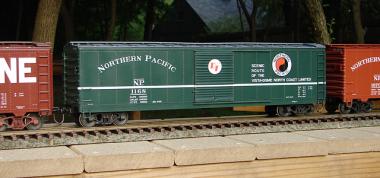Modifying MDC Boxcars
Thanks to the popularity of Aristo-Craft and USA Trains, 1:29 scale has become the de-facto standard for modeling standard gauge on 45mm (G scale) track. However, for those of us who run live steam, most of the available standard-gauge locomotives from Aster and Accucraft are in the more traditional (and gauge-accurate) scale of 1:32. Unfortunately, the selection of ready-to-run 1:32 scale rolling stock is rather limited. Accucraft/AMS makes a nice 1937 AAR boxcar these days, and MTH large scale rolling stock (also nominally 1:32) is still readily available. Model Die Casting (MDC), which was better known for their HO scale "shake-in-the-box" rolling stock kits and diecast locomotives, also produced a line of nominally 1:32 scale freight cars among other large scale offerings. MDC went out of business some years ago, but the cars from their large scale line are now being produced once again by PIKO.
A few years ago, I had the chance to buy up some old boxcar and reefer bodies that had been on the reject pile in MDC's paint shop when they shut down production, just perfect for kitbashing. Although stock MDC cars are a little toylike with their molded-on grab irons, oversized wheels, and loosely-scaled length, they can be made into a decent-looking car with a few simple modifications. Here are a couple of MDC boxcars that I have stretched to scale length and fitted with Accucraft 33" metal wheels.
The MDC boxcars are based on the 1937 AAR design (same as the Accucraft cars, naturally), and their main problem in terms of dimensions is the length - they're about three and a half scale feet too short. The width is ok give or take a couple of scale inches, and the body height is just about perfect, although the overall car height suffers because the wheels are oversized, scaling out to about 39" instead of 33" on the prototype. The boxcars have a six-foot Youngstown-style door that can be opened and closed, and is pretty much spot-on in size. There are rivet and panel lines molded into the car sides to represent a 10-panel car, with the spacing compressed to fit the shorter-than-scale car length. The roof panels, on the other hand, are just about the right size, but there is one fewer panel than there should be. That makes stretching the roof a simple matter of cutting and splicing to lengthen it by one panel to achieve the proper scale length.
The reefer bodies apparently used the same basic mold as the boxcars; the ends, floor (inside and out), and overall dimensions are identical. Only the side details are different, with a molded-on (non-working) reefer-style door that is considerably smaller than the boxcar doors, and wider spacing of the panel lines. Although this makes for an overly tall reefer, it actually worked in my favor for lengthening my boxcars, because the wider spacing of the panels on the reefers is pretty close to what the boxcars should be, so my lengthened boxcars are actually reefer bodies with boxcar door sections grafted in.
I kept the stock MDC truck sideframes (which look pretty good despite the fact that the axle spacing scales out to 5'10" instead of 5'6"), but I replaced the 39" plastic MDC wheels with 33" Accucraft/AMS metal wheelsets. The AMS axles are shorter than the stock MDC ones, so I had to make new, narrower bolsters to bring the sideframes in. I made a master out of styrene, and used that to make a rubber mold to cast new bolsters in resin.
Since I was using boxcar door sections grafted into reefer bodies to stretch the 38-foot boxcars into 41-footers, I wound up with some leftover boxcar ends in the junk pile, and I decided to splice these onto another boxcar body to create a 50-foot car. To get the 8-foot Youngstown doors, I cut and spliced a couple of MDC 6-foot doors into an 8-footer. Like the truck bolsters, I made a rubber mold from my 8-foot door to produce copies in resin.

The 41-foot cars were sprayed with red oxide primer, with the redder color of the Northern Pacific car coming from a Krylon can, and the browner color on the Chicago & Northwestern car coming from the Rust-Oleum "Painter's Touch" line. The NP green on the 50-footer was mixed from Badger ModelFlex paints and airbrushed. I created the artwork for the decals on my computer, and printed them on my old Alps printer using Micro-Mark decal paper. All of the cars are fitted with body-mounted Kadee couplers.
- rjenkins's blog
- Log in to post comments

Comments
jcfgrr
Thu, 2014-01-09 08:45
Permalink
boxcar convertion.
Great boxcar convertion.
John F